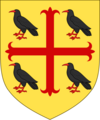Edmund of Abingdon facts for kids
Quick facts for kids Edmund |
|
|---|---|
| Archbishop of Canterbury | |
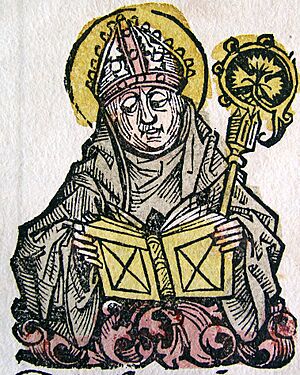
Image of Edmund from the Nuremberg Chronicle (1493)
|
|
| Appointed | 1233 |
| Reign ended | 1240 |
| Predecessor | John Blund |
| Successor | Boniface of Savoy |
| Orders | |
| Consecration | 2 April 1234 |
| Personal details | |
| Born | perhaps 20 November c. 1174 St Edmund's Lane, Abingdon, Berkshire (now Oxfordshire), England |
| Died | 16 November 1240 Soisy-Bouy, Seine-et-Marne, France |
| Buried | Pontigny Abbey, Burgundy, France |
| Coat of arms |  |
| Sainthood | |
| Feast day | 16 November |
| Venerated in | Catholic Church Anglican Communion |
| Title as Saint | Archbishop |
| Canonized | 16 December 1246 by Pope Innocent IV |
| Attributes | archbishop making a vow before a statue of the Blessed Virgin Mary; embracing the Child Jesus; placing a ring on the finger of a statue of the Blessed Virgin Mary; receiving a lamb from the Blessed Virgin Mary; with Saint Richard of Chichester; with Saint Thomas of Canterbury |
| Patronage | Abingdon, Oxfordshire; Roman Catholic Diocese of Portsmouth; St Edmund's College, Cambridge; St Edmund Hall, Oxford ; St Edmund’s College, Ware. |
| Shrines | Pontigny Abbey, Pontigny, Yonne, France |
Edmund of Abingdon (also known as Edmund Rich or St Edmund of Canterbury) was an important English Catholic leader. He lived from about 1174 to 1240. He became the Archbishop of Canterbury, a very high position in the Church.
Edmund was a respected teacher at the Universities of Paris and Oxford. He taught subjects like mathematics, logic, and theology (the study of religious faith). He also helped introduce the ideas of the ancient Greek thinker Aristotle.
Even before becoming a priest, Edmund was known for living a very simple and strict life. After becoming a priest, he was famous for his lectures and for being a popular speaker. He traveled a lot in England, giving sermons. In 1227, he even helped encourage people to join the Sixth Crusade.
He was asked to become Archbishop of Canterbury by Pope Gregory IX. Edmund was a gentle person, but he was also very strong in his beliefs. He stood up to King Henry III to protect the Magna Carta. This important document limited the king's power. Edmund also worked for good government and justice in both the country and the Church. He helped make peace with Llywelyn the Great, a powerful Welsh prince.
Because of his strong actions, King Henry III and some monasteries did not like him. Edmund died in France in 1240 while traveling to Rome. He was made a saint in 1246.
Contents
Who was Edmund of Abingdon?
Edmund's Early Life and Studies
Edmund was born around 1174 in Abingdon, England. This town is about seven miles south of Oxford. He had two sisters and at least one brother.
His father, Reynold, was a wealthy merchant. He was sometimes called "Rich," but this nickname was not used for Edmund. His father later became a monk, and Edmund's mother, Mabel, took care of the family. She was a very religious woman who lived a simple life. She encouraged her children to do the same. Both of Edmund's sisters became nuns.
Edmund likely went to school at Abingdon Abbey. He loved learning about religion. When he was 12, he promised to live a life of purity. He studied in England and then went to the University of Paris in France. Around 1195, he and his brother Richard went to study in Paris. He taught at Oxford and Paris around 1200. For six years, he taught mathematics and logic. He helped bring the ideas of Aristotle to these universities.
Edmund was one of the first teachers at Oxford to earn a Master of Arts degree. He spent many hours praying at night. This sometimes made him fall asleep during his lectures! It is believed he used his teaching fees to help build the Lady Chapel at St Peter's in the East in Oxford. The place where he lived and taught later became St Edmund Hall, Oxford, a college at Oxford University.
His mother encouraged him to study theology, which is the study of religious faith. Edmund was not sure at first, but he began his new path between 1205 and 1210. He spent a year at Merton Priory, a religious house. He became a priest and earned a doctorate in theology. He became known for his theology lectures and for being a great speaker. He gave away the money he earned from teaching to charity. He also often went to Reading Abbey for quiet time and prayer.
Between 1219 and 1222, he became a church leader in Calne, Wiltshire. He also became the treasurer of Salisbury Cathedral. He held this job for eleven years and continued to preach. In 1227, he traveled across England to encourage people to join the Sixth Crusade. He became good friends with Ela, Countess of Salisbury, and her husband, William Longespée. He was known for his kindness and for living a very strict life.
Becoming Archbishop of Canterbury
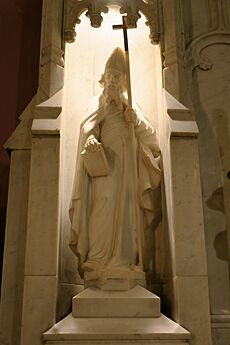
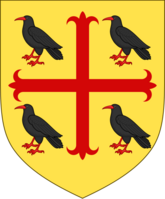
In 1233, Edmund was chosen by Pope Gregory IX to be the Archbishop of Canterbury. This was a very important job. The Church leaders had already chosen three other people, but the Pope did not approve them. Edmund's name was suggested as a compromise, perhaps because of his work for the crusade. He became archbishop on April 2, 1234.
Before becoming archbishop, Edmund was known for supporting the Church's independence from Rome. He also wanted to protect the Magna Carta and keep foreigners from holding important jobs in England. He did not want to be archbishop, but he was convinced. People told him that if he refused, the Pope might choose a foreign leader instead. He chose Richard of Wich, who later became St Richard of Chichester, as his assistant.
On February 2, 1234, Edmund spoke to King Henry III of England at Westminster. He told the king to learn from his father, John of England. A week after becoming archbishop, Edmund again met with the king, along with other leaders. This time, they threatened to remove Henry from the Church if he did not fire his advisors. Many of these advisors were foreigners, especially Peter des Roches. Henry agreed, and his favorites were dismissed. Hubert de Burgh was released from prison and made up with the king. Soon after, Edmund was sent to Wales to make peace with Llywelyn the Great. Edmund's success, however, made the king angry with him.
The local people respected Edmund for his teaching, preaching, and prayers. But he was very strict about good rules in government and the Church. He also wanted monasteries to follow their rules closely. This caused problems with King Henry III, several monasteries, and even the priests at Canterbury Cathedral. He had to fight in court to keep his authority.
In 1236, the king asked the Pope to send a special representative, called a legate. The king wanted to free himself from Edmund's control. When Cardinal Odo arrived in 1237, Edmund found his efforts blocked. The marriage between Simon de Montfort and Henry's sister Eleanor was approved in Rome. Edmund had said this marriage was not valid. The king and the legate supported the monks of Canterbury against Edmund's authority. Edmund complained to the king. He also generally removed from the Church anyone who harmed the freedoms of Canterbury. But these actions did not work. The Pope would not change the legate's decisions. Edmund felt that the Church's rules were being ruined. He began to think about leaving his position.
Travels and Death
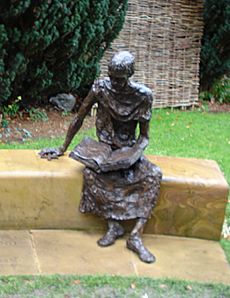
Even though Edmund was gentle, he strongly defended the rights of the Church and the country. He stood against King Henry III's unfair demands. In December 1237, Edmund went to Rome to argue his case in person. He returned to England in August 1238, but his efforts to make changes were stopped. Edmund agreed to the Pope's demands. In early 1240, he paid one-fifth of his income to the Pope's agents. This money was for the Pope's war against Emperor Frederick II. Other English church leaders followed his example.
The Pope then ordered that 300 church jobs in England should be given to Romans. In 1240, Edmund set out for Rome again. He became sick at Pontigny Abbey, a monastery in France. He started traveling back to England but died only 50 miles further north. He passed away on November 16, 1240, at a house of religious canons in Soisy-Bouy. His body was taken back to Pontigny.
Becoming a Saint
Less than a year after Edmund died, people said that miracles were happening at his grave. Even though King Henry was against it, Edmund was made a saint just six years after his death, in December 1246. His special day is November 16.
A few years later, the first chapel dedicated to him was built in Dover. It was called St Edmund's Chapel. His friend Richard of Chichester dedicated it. This small building is still there today.
In Salisbury, a church founded in 1269 was dedicated to Edmund. It was rebuilt in 1407 and is now the Salisbury Arts Centre. An altar in the cathedral is also dedicated to him.
Today, he is remembered in the names of St Edmund Hall, Oxford and St Edmund's College, Cambridge. Many other schools and churches are also named after him.
Edmund's Relics
Edmund's body was never moved to Canterbury. This was because the monks there were upset about what they saw as Edmund's attacks on their independence. After he died, he was taken back to Pontigny Abbey. Most of his remains are still there in a special container from the 1600s.
One of his arms is kept in a chapel in Connecticut, USA. In 1853, a bone from his left leg was given to St Edmund's College in Ware, England. Many people said they were cured of serious illnesses after praying to St Edmund. One early example was a student who was badly hurt in 1871. His full recovery led to a new chapel being built to honor the saint.
An old silk robe, likely made in Spain, that Edmund had with him when he died is still kept in a local church.
Edmund's Character
Edmund lived a life of giving and helping others. From a young age, he practiced asceticism, which means living a very simple and strict life. For example, he would fast on Saturdays, eating only bread and water. He also wore a hair shirt, which was uncomfortable. After only a few hours of sleep, he would spend most of the night praying and thinking.
Edmund's Writings
Edmund wrote a book called Speculum ecclesiae, which means 'Mirror of the Church'. This book was about the Christian faith. It was later translated into French as Mirour de Seinte Eglyse. This version was meant for religious people. There was also a simpler version for everyday people.
The Society of Saint Edmund
Edmund's life inspired the creation of the Society of Saint Edmund. This group was formed in France in 1843. Its goal was to keep Edmund's memory alive. They wanted to help people reconnect with their faith. Members of the Society moved to the United States in 1889.
The Society of Saint Edmund settled in Vermont and started Saint Michael's College in 1904. Today, members of the Society work in churches in Vermont. They also help the African American community through the Edmundite Missions in Selma, Alabama. They are involved in higher education at Saint Michael's College and lead retreats in Connecticut and Vermont.
Images for kids




